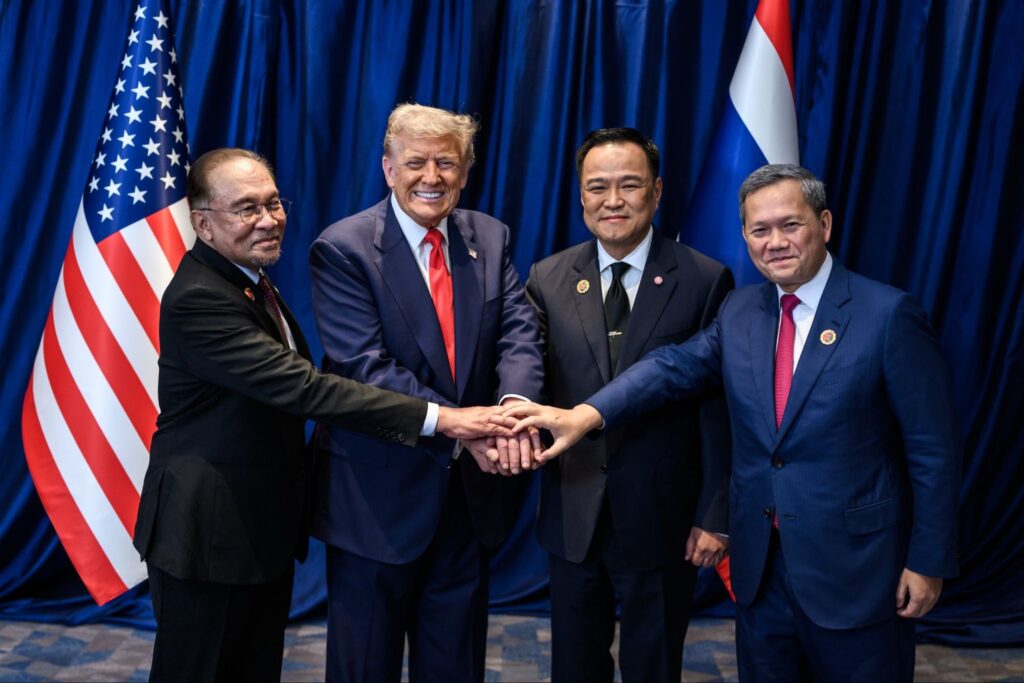KUALA LUMPUR. MALAYSIA Oct 26. 2025 – In a landmark moment for Southeast Asian stability, leaders from Thailand and Cambodia signed the Kuala Lumpur Peace Accords on Sunday, formally resolving long-standing border disputes that have simmered for decades and occasionally erupted into deadly clashes. U.S. President Donald Trump presided over the ceremony at the ongoing ASEAN summit here, hailing the agreement as a “historic milestone” and reaffirming America’s commitment to regional peace.
The accords, inked in the presence of Malaysian Prime Minister Dato’ Seri Anwar Ibrahim and Trump, mark the first comprehensive framework to address territorial claims along the shared 800-kilometer border, particularly around the contested Preah Vihear temple area. The deal includes immediate steps such as Thailand’s release of 18 detained Cambodian soldiers, the mutual withdrawal of heavy weaponry, and the clearance of landmines from sensitive zones. It also establishes new bilateral guidelines for joint patrols, dispute resolution mechanisms, and economic cooperation to foster trust between the neighboring nations.
“This is the beginning of a new era of peace and prosperity in Southeast Asia,” Trump declared during the signing ceremony, flanked by the leaders under a backdrop of national flags. “The Kuala Lumpur Peace Accords have been SIGNED, marking a historic milestone in resolving border tensions between Thailand and Cambodia.” The U.S. president’s involvement underscores his administration’s “Peace President” agenda, which has prioritized diplomatic interventions in global hotspots since taking office earlier this year.
Cambodian Prime Minister Hun Manet and Thai Prime Minister Anutin Charnvirakul affixed their signatures to the joint declaration, witnessed by Anwar and Trump. The document, released by the White House, emphasizes quadruplicate English-language copies to ensure transparency and enforceability. While Trump touted the pact as a definitive resolution, Thai officials described it more cautiously as “a pathway to peace,” reflecting ongoing sensitivities over implementation.
The border conflict dates back to the 1960s, exacerbated by a 1962 International Court of Justice ruling awarding the Preah Vihear temple to Cambodia, which Thailand has contested. Clashes in 2008 and 2011 left dozens dead and displaced thousands, straining relations and hindering regional economic integration. ASEAN’s mediation efforts, hosted by Malaysia during its 2025 chairmanship of the bloc, provided the neutral ground for these talks, with Trump’s surprise attendance injecting high-level momentum.
Analysts view the accords as a diplomatic win for all parties, potentially unlocking billions in cross-border trade and tourism. “This agreement could transform the Mekong subregion into an economic powerhouse,” said a Reuters report on the summit’s broader outcomes, which also featured U.S.-ASEAN trade discussions led by Trump. However, skeptics warn that full demilitarization and cultural heritage protections will require sustained international monitoring to prevent backsliding.
The signing unfolded amid the 47th ASEAN summit, where Trump headlined sessions on supply chain resilience and countering external influences in the South China Sea. Footage from the event captured the leaders clasping hands in a symbolic gesture of unity, a moment quickly shared by the White House on social media to widespread acclaim.
As the ink dries on this chapter of reconciliation, eyes turn to how the accords’ provisions will be operationalized in the coming months. For now, the streets of Kuala Lumpur buzz with cautious optimism, a far cry from the artillery echoes of years past.

